 |
市場調查報告書
商品編碼
1664868
石油和天然氣市場中的區塊鏈機會、成長動力、產業趨勢分析和 2025 - 2034 年預測Blockchain in Oil and Gas Market Opportunity, Growth Drivers, Industry Trend Analysis, and Forecast 2025 - 2034 |
||||||
2024 年全球石油和天然氣區塊鏈市場價值為 9.844 億美元,預計 2025 年至 2034 年期間的複合年成長率將達到 41.9%。 區塊鏈技術是一種分散的數位分類帳系統,它透過提供安全、防篡改的交易記錄,徹底改變了石油和產業。對於要求無與倫比的透明度和營運效率的行業來說,這項尖端技術即將帶來革命。

石油和天然氣產業變得越來越複雜,推動了對區塊鏈等創新解決方案的需求。透過自動化交易和簡化流程,區塊鏈大大減少了對手動文書工作的依賴,減少了延誤、錯誤和詐欺。這些優勢使區塊鏈成為最佳化資源和材料管理同時提高整體供應鏈效率的不可或缺的工具。
| 市場範圍 | |
|---|---|
| 起始年份 | 2024 |
| 預測年份 | 2025-2034 |
| 起始值 | 9.844億美元 |
| 預測值 | 291.6億美元 |
| 複合年成長率 | 41.9% |
區塊鏈技術在整個石油和天然氣價值鏈中有著廣泛的應用,包括供應鏈管理、營運、交易和安全。尤其是供應鏈領域,預計資料佔據主導地位,預計到 2034 年將產生 155 億美元的產值。透過區塊鏈實現跨區域材料和產品的追蹤,企業可以增強庫存管理和預測準確性,使其成為產業轉型的基石。
市場分為公共和私人區塊鏈解決方案。預計到 2034 年,公共區塊鏈的複合年成長率將達到驚人的 42.4%。此外,對永續實踐和遵守環境法規的日益重視進一步推動了公共區塊鏈解決方案的採用。
在美國,石油和天然氣市場的區塊鏈規模預計到 2034 年將達到 38 億美元。區塊鏈技術確保了整個供應鏈從開採到最終分銷的責任。此外,嚴格的環境和安全法規以及財務揭露要求正在加速區塊鏈的採用。私人企業與政府機構之間的合作試點計畫進一步推動了美國市場的擴張
目錄
第 1 章:方法論與範圍
- 市場定義
- 基礎估算與計算
- 預測計算
- 初步研究與驗證
- 主要來源
- 資料探勘來源
- 市場定義
第 2 章:執行摘要
第 3 章:產業洞察
- 產業生態系統
- 監管格局
- 產業衝擊力
- 成長動力
- 產業陷阱與挑戰
- 成長潛力分析
- 波特的分析
- 供應商的議價能力
- 買家的議價能力
- 新進入者的威脅
- 替代品的威脅
- PESTEL 分析
第4章:競爭格局
- 介紹
- 戰略儀表板
- 創新與技術格局
第 5 章:市場規模及預測:依類別,2021 – 2034 年
- 主要趨勢
- 民眾
- 私人的
第 6 章:市場規模與預測:按應用,2021 – 2034 年
- 主要趨勢
- 供應鏈
- 營運
- 貿易
- 安全
第 7 章:市場規模及預測:按地區,2021 – 2034 年
- 主要趨勢
- 北美洲
- 美國
- 加拿大
- 墨西哥
- 歐洲
- 德國
- 英國
- 荷蘭
- 法國
- 西班牙
- 亞太地區
- 中國
- 日本
- 新加坡
- 澳洲
- 中東和非洲
- 沙烏地阿拉伯
- 阿拉伯聯合大公國
- 南非
- 拉丁美洲
- 巴西
- 智利
第8章:公司簡介
- Accenture
- ConsenSys
- Hindustan Petroleum
- IBM
- Infosys Limited
- Kaleido
- Neoflow
- SAP
- VAKT Global
- VeChain
- Zupple Labs
The Global Blockchain In Oil And Gas Market, valued at USD 984.4 million in 2024, is projected to surge at a remarkable CAGR of 41.9% between 2025 and 2034. Blockchain technology, a decentralized digital ledger system, is revolutionizing the oil and gas sector by providing secure, tamper-proof transaction recording. This cutting-edge technology is emerging as a game-changer for an industry that demands unparalleled transparency and operational efficiency.

The oil and gas industry is becoming increasingly complex, driving the need for innovative solutions like blockchain. By automating transactions and streamlining processes, blockchain significantly reduces the reliance on manual paperwork, cutting down delays, errors, and fraud. These advantages position blockchain as an indispensable tool for optimizing resource and material management while enhancing overall supply chain efficiency.
| Market Scope | |
|---|---|
| Start Year | 2024 |
| Forecast Year | 2025-2034 |
| Start Value | $984.4 Million |
| Forecast Value | $29.16 Billion |
| CAGR | 41.9% |
Blockchain technology finds diverse applications across the oil and gas value chain, including supply chain management, operations, trading, and security. The supply chain segment, in particular, is poised to dominate, projected to generate USD 15.5 billion by 2034. The need for real-time data sharing among stakeholders is a primary driver of this growth. With blockchain-enabled tracking of materials and products across multiple regions, companies can enhance inventory management and forecasting accuracy, making it a cornerstone of industry transformation.
The market is categorized into public and private blockchain solutions. Public blockchains are anticipated to experience an impressive CAGR of 42.4% through 2034. Governments and public agencies increasingly favor public blockchains for their transparency and ability to combat corruption in resource management. Moreover, the rising emphasis on sustainable practices and compliance with environmental regulations further bolsters the adoption of public blockchain solutions.
In the United States, the blockchain in oil & gas market is forecast to reach USD 3.8 billion by 2034. Growing regulatory scrutiny, investor demands, and public expectations are driving the need for transparent and immutable record-keeping systems. Blockchain technology ensures accountability across the supply chain, from extraction to final distribution. Additionally, stringent environmental and safety regulations, along with financial disclosure requirements, are accelerating blockchain adoption. Collaborative pilot projects between private companies and government bodies further fuel market expansion in the U.S.
Table of Contents
Chapter 1 Methodology & Scope
- 1.1 Market definitions
- 1.2 Base estimates & calculations
- 1.3 Forecast calculation
- 1.4 Primary research & validation
- 1.4.1 Primary sources
- 1.4.2 Data mining sources
- 1.5 Market Definitions
Chapter 2 Executive Summary
- 2.1 Industry synopsis, 2021 – 2034
Chapter 3 Industry Insights
- 3.1 Industry ecosystem
- 3.2 Regulatory landscape
- 3.3 Industry impact forces
- 3.3.1 Growth drivers
- 3.3.2 Industry pitfalls & challenges
- 3.4 Growth potential analysis
- 3.5 Porter's analysis
- 3.5.1 Bargaining power of suppliers
- 3.5.2 Bargaining power of buyers
- 3.5.3 Threat of new entrants
- 3.5.4 Threat of substitutes
- 3.6 PESTEL analysis
Chapter 4 Competitive landscape, 2024
- 4.1 Introduction
- 4.2 Strategic dashboard
- 4.3 Innovation & technology landscape
Chapter 5 Market Size and Forecast, By Category, 2021 – 2034 (USD Million)
- 5.1 Key trends
- 5.2 Public
- 5.3 Private
Chapter 6 Market Size and Forecast, By Application, 2021 – 2034 (USD Million)
- 6.1 Key trends
- 6.2 Supply chain
- 6.3 Operations
- 6.4 Trading
- 6.5 Security
Chapter 7 Market Size and Forecast, By Region, 2021 – 2034 (USD Million)
- 7.1 Key trends
- 7.2 North America
- 7.2.1 U.S.
- 7.2.2 Canada
- 7.2.3 Mexico
- 7.3 Europe
- 7.3.1 Germany
- 7.3.2 UK
- 7.3.3 Netherlands
- 7.3.4 France
- 7.3.5 Spain
- 7.4 Asia Pacific
- 7.4.1 China
- 7.4.2 Japan
- 7.4.3 Singapore
- 7.4.4 Australia
- 7.5 Middle East & Africa
- 7.5.1 Saudi Arabia
- 7.5.2 UAE
- 7.5.3 South Africa
- 7.6 Latin America
- 7.6.1 Brazil
- 7.6.2 Chile
Chapter 8 Company Profiles
- 8.1 Accenture
- 8.2 ConsenSys
- 8.3 Hindustan Petroleum
- 8.4 IBM
- 8.5 Infosys Limited
- 8.6 Kaleido
- 8.7 Neoflow
- 8.8 SAP
- 8.9 VAKT Global
- 8.10 VeChain
- 8.11 Zupple Labs










